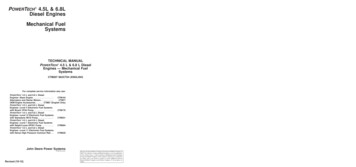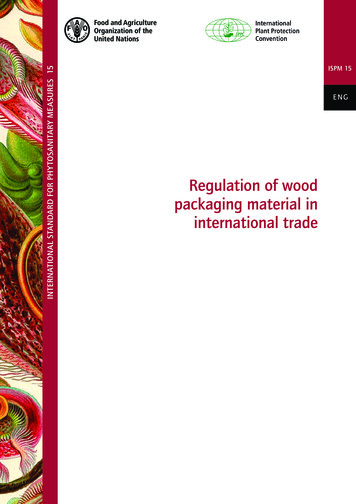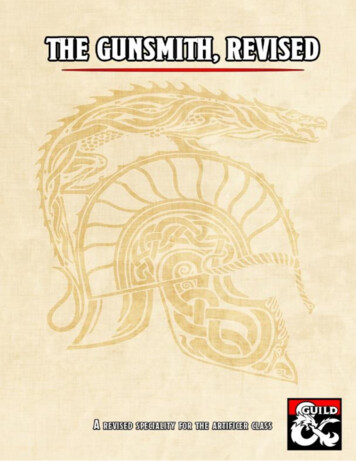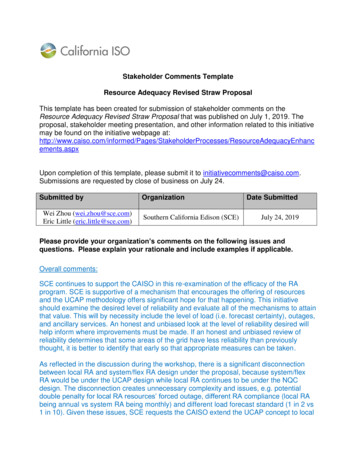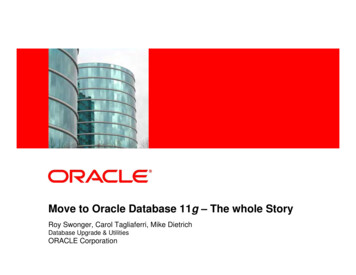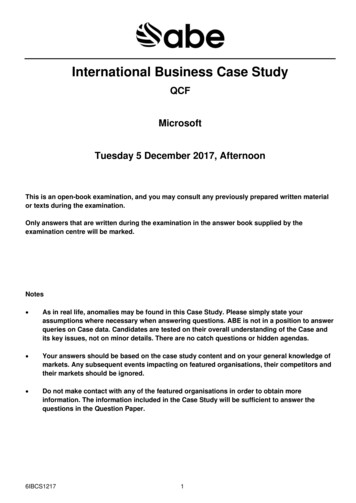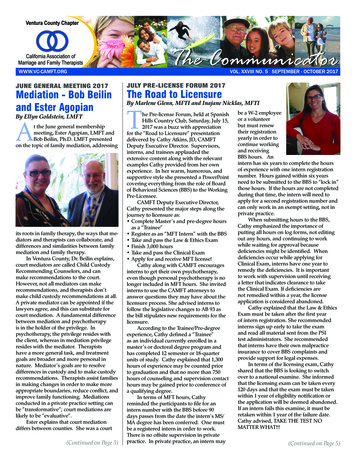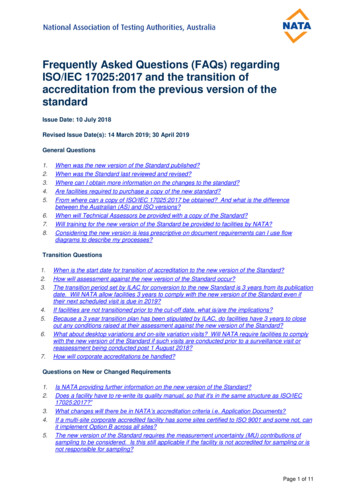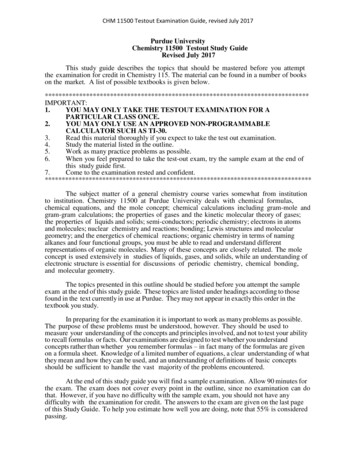
Transcription
CHM 11500 Testout Examination Guide, revised July 2017Purdue UniversityChemistry 11500 Testout Study GuideRevised July 2017This study guide describes the topics that should be mastered before you attemptthe examination for credit in Chemistry 115. The material can be found in a number of bookson the market. A list of possible textbooks is given *********************************IMPORTANT:1.YOU MAY ONLY TAKE THE TESTOUT EXAMINATION FOR APARTICULAR CLASS ONCE.2.YOU MAY ONLY USE AN APPROVED NON-PROGRAMMABLECALCULATOR SUCH AS TI-30.3.Read this material thoroughly if you expect to take the test out examination.4.Study the material listed in the outline.5.Work as many practice problems as possible.6.When you feel prepared to take the test-out exam, try the sample exam at the end ofthis study guide first.7.Come to the examination rested and ***************************************The subject matter of a general chemistry course varies somewhat from institutionto institution. Chemistry 11500 at Purdue University deals with chemical formulas,chemical equations, and the mole concept; chemical calculations including gram-mole andgram-gram calculations; the properties of gases and the kinetic molecular theory of gases;the properties of liquids and solids; semi-conductors; periodic chemistry; electrons in atomsand molecules; nuclear chemistry and reactions; bonding; Lewis structures and moleculargeometry; and the energetics of chemical reactions; organic chemistry in terms of namingalkanes and four functional groups, you must be able to read and understand differentrepresentations of organic molecules. Many of these concepts are closely related. The moleconcept is used extensively in studies of liquids, gases, and solids, while an understanding ofelectronic structure is essential for discussions of periodic chemistry, chemical bonding,and molecular geometry.The topics presented in this outline should be studied before you attempt the sampleexam at the end of this study guide. These topics are listed under headings according to thosefound in the text currently in use at Purdue. They may not appear in exactly this order in thetextbook you study.In preparing for the examination it is important to work as many problems as possible.The purpose of these problems must be understood, however. They should be used tomeasure your understanding of the concepts and principles involved, and not to test your abilityto recall formulas or facts. Our examinations are designed to test whether you understandconcepts rather than whether you remember formulas – in fact many of the formulas are givenon a formula sheet. Knowledge of a limited number of equations, a clear understanding of whatthey mean and how they can be used, and an understanding of definitions of basic conceptsshould be sufficient to handle the vast majority of the problems encountered.At the end of this study guide you will find a sample examination. Allow 90 minutes forthe exam. The exam does not cover every point in the outline, since no examination can dothat. However, if you have no difficulty with the sample exam, you should not have anydifficulty with the examination for credit. The answers to the exam are given on the last pageof this Study Guide. To help you estimate how well you are doing, note that 55% is consideredpassing.
CHM 11500 Testout Examination Guide, revised July 2017Suggested Textbooks:Chemistry & Chemical Reactivity, 9th ed by Kotz, Treichel & Townsend;Thomson/Brooks/Cole. ISBN-13: 978-1285462530.Chemistry: The Molecular Nature of Matter and Change, 8th edition by Silberberg; McGrawHill. ISBN-13: 978-1259631757.Chemistry, the Central Science by Brown, 13th edition by LeMay, Bursten & Murphy; PrenticeHall. ISBN-13: 978-0321910417.
Chem 11500 Test-out Exam Study GuideCHEMISTRY 11500 STUDY GUIDEStudents should be able to use the metric system, know how to measure mass, volume, andtemperature, be able to convert between different units, use significant figures.1. The mole, chemical formulas, and chemical equations.You should know the relationships between a mole of material and its weight, volume,concentration, or the number of atoms or molecules.You should be able to write the correct formula given the name of any "common" chemicalcompound; or given the formula, write the name.Given the formula for any compound you should be able to:(a)(b)(c)(d)name the elements that make up the compound.indicate the number of each kind of atom represented.determine the mass of each element in one mole of compound.calculate the molecular weight.Given the weight of a sample and the formula of the compound, you should be able tocalculate:(a)(b)(c)(d)the number of moles of the compound in the sample.the number of moles of any one element in the sample.the number of molecules in the sample.the number of atoms of any one element in the sample.2. Chemical stoichiometryGiven all reactants and products for a chemical reaction, and any one of the following piecesof information, you should be able to calculate any other piece of information on the list.(a)(b)(c)(d)(e)the number of moles of one of the products or reactants.the mass of any product or reactant.the number of molecules of any product or reactant.the number of atoms or mass of any single element involved.the concentration and volume of a solution of reactant or product.Given the weight of two or more reactants or products in a chemical reaction you should beable to identify the limiting reagent, calculate the weight of any reactant consumed in thereaction, calculate the weight of any product produced in the reaction, and determine theweight of the excess reactant left over when the reaction has reached completion.Calculate and use percent yield.
Chem 11500 Test-out Exam Study Guide3. Properties of gases.Given any three of the following pieces of information, you should be able to calculate thefourth, assuming that the gas is ideal.(a)(b)(c)(d)the number of moles of gas, or the weight of the gasthe pressure of the gasthe volume of the gasthe temperature of the gasGiven the volume of a gas at one temperature and pressure, you should be able to find thevolume it would occupy at another temperature and pressure.You should be able to determine the density of a gas from the pressure and temperature. Youshould be able to determine the molecular weight of a gas from its density.From the equation for a reaction involving a gas, and the mass, moles or volume of a gaseousreactant, you should be able to find the mass, moles or volume of any other product orreactant.4. Properties of liquids.You should be able to use a microscopic or atomic/molecular scale model to describe thechanges which occur when a solid becomes a liquid, or when a liquid becomes a gas. Youshould be able to explain the differences in the arrangements of the atoms or molecules, whathappens to the average speed of the particles, what changes occur in the distance betweenparticles, and the temperature changes that must occur.You should know how to prepare a specified volume of a solution of known concentration,e.g., 200 mL of 0.100 M NaCl. You should be able to calculate the number of moles, thenumber of moles of ions produced, or the mass of solute dissolved in a given volume ofsolution of known concentration, e.g., how many grams of NaCl are present in 50.0 mL of a1.50 M solution? You should be able to use a solution of known concentration to prepare asolution of a lower concentration by dilution, e.g., prepare 100 mL of 0.22 M HCl startingwith a solution that is 2.50 M HCl.Given the boiling point of a pure solvent, its molal boiling point elevation constant, and themolality of the solution, you should be able to calculate the boiling point of the solution.Conversely, you should be able to find the molality of a solution from the boiling point ofthat solution. You should be able to find the molecular weight of a solute from the molalityof the solution, the boiling point of the solution, the boiling point of the pure solvent, and themolal boiling point elevation constant.You should be able to calculate the freezing point of a solution from the freezing point of thepure solvent, its molal freezing point depression constant, and the molality of the solution.You should be able to find the molecular weight of a solute from the molality of the solution,the freezing point of the solution, the freezing point of the pure solvent, and the molalfreezing point depression constant.4
Chem 11500 Test-out Exam Study Guide5.Properties of solids.Identify the common cubic unit cells – cubic, face centered cubic, and body centered cubic,and know how many atoms are in each and where each is positioned.You should be able to calculate any of the following quantities from some or all of the othermeasurements.(a)(b)(c)(d)(e)(f)(g)unit cell edgelocations of atomsinteratomic distancesdensity of the solidnumber of formula units per unit celltype of cubic crystal latticecoordinates of the atoms in the unit cell6. Ions, naming, and periodic chemistry.Identify the charge of main group monoatomic cations and anions based upon placement inthe periodic table.Identify the following ions based upon formula, correct charge, and or ball and stick image:chlorate, chlorite, cyanide, acetate, hydroxide, sulfate, sulfite, carbonate, nitrate, nitrite,phosphate, and phosphite.Name and write formulas of ionic compounds of these ions such as CaCl2 calcium chlorideor FeCl3, Iron (III) Chloride.Name and write the formulas of molecular compounds.Name and write formulas for the seven strong acids, carbonic acid, and acetic acid.Name and write formulas for binary covalent (molecular) compounds.Name simple alkanes up to six carbons. Read and identify organic molecules that arerendered as ball and stick models and skeleton diagrams.Identify the following organic functional groups associated with the following classes oforganic compounds in a molecule: alcohols, aldehydes, ketones, carboxylic acids, amines,esters, ethers, and amides.Indicate whether a property such as, ionization energy, electronegativity, atomic weight,ionic radius, or atomic radius increases or decreases as we proceed down a column or acrossa row of the Periodic Table. Compare periodic properties among a group of elements orions.7. Electronic structure of atoms.Given the symbol for an element or ion, and a Periodic Table, you should be able to determinethe number of protons in the nucleus of that particle, and the number of electrons around thenucleus. Given the symbol for an isotope, you should be able to identify the numbers ofprotons, neutrons, and electrons (or vice versa).5
Chem 11500 Test-out Exam Study GuideFrom the position of the element in the Periodic Table you should be able to indicate thenumber of electrons in the outer or valence shell. Conversely, knowing the number ofelectrons in the valence shell, you should be able to identify the family or Group to whichthe elements belongs (thus, you should know the names of the families of elements in theperiodic table).You should be able to identify the orbitals that contain the valence electrons for any elementin the Periodic Table. From the atomic number of an element or from a Periodic Table, youshould be able to write the electronic configuration for any element, i.e., ls2 2s2 2p6.etc.8. Chemical bonding and related topics.Given the symbol, name or atomic number for any element, you should be able to write theLewis structure of that element. You should be able to write the Lewis or electron dotstructure for any compound containing no more than three elements or if the connectivity ofthe atoms is given you should be able to complete it.From the chemical and physical properties of a compound, e.g., the conductivity, meltingpoint, heat of fusion, etc., you should be able to predict whether that compound is ionic orcovalent.Given a sample of an unknown compound, you should be able to describe a test that youcould perform that would help you decide whether the compound is ionic or covalent.You should be able to use a table of electronegativities to determine where the bond betweentwo elements would best be described as ionic or covalent.Using values for the radii of ions and/or the Periodic Table you should be able to predictwhich ionic compound will have the largest crystal lattice energy, e.g., which has the highercrystal lattice energy, Na2O or MgO?From the electron-dot or Lewis structure of a molecule you should be able to identify thedistribution of bonding and non-bonding electron pairs. You should be able to predict theshape of the molecule including linear, trigonal planar, and tetrahedral and their derivatives(trigonal bipyramidal and octahedral are not included). Additionally, you should be able toidentify if a molecule is polar.If there are several acceptable Lewis structures for a given molecule, you should be able towrite all possible resonance structures, and understand the implication of the existence ofthese resonance structures. Identify when a molecule or ion may have resonance structures.You should be able to identify the atomic orbitals that are used to form bonds in covalentmolecules. For example, when HF forms, what atomic orbitals overlap to form the bond?You should be able to draw diagrams that show how atomic orbitals overlap to form doubleand triple bonds, and you should be able to identify the atomic orbitals that form the sigmaand pi bonds in these compounds.You should understand what is meant by hybrid atomic orbitals and the shape of moleculesthat use sp, sp2, or sp3, hybrid orbitals, especially in organic molecules.6
Chem 11500 Test-out Exam Study Guide9. Chemical energetics.You should be able to distinguish between exothermic and endothermic reactions, betweenreactions which lose heat and which gain heat from their surroundings, and reactions whichshould be identified by H – or H . You should be able to describe the conditionsthat are implied for solids, liquids, and gases when values of the standard state enthalpy, ÄH,are given.Given an equation and the standard enthalpy of formation of each compound in the reaction,you should be able to calculate the change in the enthalpy for the reaction. (Note, this is onlyone of many different kinds of problems in which Hess' Law can be applied.) You should beable to set up reactions in the form of a series of small "steps" starting with the reactants andending up with the products, and construct an enthalpy of reaction from these steps.You should be able to use bond dissociation energies to estimate the enthalpy of reaction forreactions in which enthalpy of formation data are not available for all reactants and products.10. Nuclear chemistry and reactionsDefine radioactivity, nucleon, nuclide and isotope.Describe the characteristics of radioactive emissions.Use the concepts of radioactive decay and half-life to find the age of an object, decayconstant half-life, or amount of material remaining.11. Science PracticesThe ideas of science and engineering cannot be engaged in and applied in the absence ofinquiry and discourse that allow for the development and refinement of models and ideas.These are more than skills in the sense that they are applied knowledge that is specific toeach practice below. Analyze and interpret dataUse math and computational thinkingConstruct explanations (and evaluate them)Develop an argument from evidence (and evaluate them)7
Chem 11500 Test-out Exam Study Guide8Sample Test for Chemistry 115001.2.3.4.This exam consists of 47 multiple choice questions.For each question mark the one best answer.Allow 90 minutes for this sample exam.During the actual examination for credit, a list of the elements and their atomicweights will be provided. You should use such a list (not a Periodic Table) for thisexam.5. The answers may be found on the last page.Questions 1-6 pertain to the following hydrocarbon combustion reaction:C7H16 11 O2 7 CO2 8 H2O1. What is the molar mass of C7H16 ?(a) 22.4(b) 86.1(c) 100.2(d) 716(e) 1102.2Make sure of this answer since the next five depend on it!2. How many moles of CO2 will be produced by the combustion of 30 g of C7H16 ?(a) 210(b) 21(c) 2.1(d) 0.3(e) 3.33. If the prevailing temperature is 0o C and the prevailing pressure 3 atmospheres, whatvolume of CO2 can be produced from 10 g of C7H16?(a) 0.7 L(b) 2.1 L(c) 15.7 L(d) 5.22 L(e) 47.1 L4. The density of C7H16 at 273o C and 2 atmospheres pressure would be:(a) 4.46 g/L(b) 8.92 g/L(c) 2.23 g/L(d) 1.12 g/L(e) 100 g/L5. What weight of H2O would be formed by the combustion of 20 g of C7 H16?(a) 3.6 g(b) 160 g(c) 144 g(d) 28.8 g(e) 62 g6. 1 mole of C7H16 and 11 moles of O2 are caused to react in a closed container atsuch a temperature that all reactants and products are gases. The final pressure is:(a) the same as the initial pressure.(b) 5/4 times the initial pressure.(c) 15 times the initial pressure.(d) 15/11 times the initial pressure.(e) 15/12 times the initial pressure.
Chem 11500 Test-out Exam Study Guide7. If a single molecule of a substance weighs 5.34 x 10–23g, the molecular weight mustbe:(a) 28.1(b) 32.148. The difference between(a)(b)(c)(d)(e)(c) 56.2and(d) 64.28(e) 128.56is:one electron.one proton.one electron and one proton.one neutron.not distinguishable.9. A 1986 penny of mass 2.48 g is 6% copper by mass. How many copperatoms [AW Cu 63.55] are contained in the penny?(a) 2.34 x 10 –3(b) 3.81(c) 6.022 x 1023(d) 3.613 x 1022(e) 1.41 x 102110. Ammonia (NH3 ) reacts with O2 as follows: 4 NH3 5 O2 6 H2O 4 NOHow many liters of O2 (at STP) react with one mole of NH3?(a) 5 L(d) 5 x 22.4 L4(b) 5 x 22.4 L(e) 10 x 22.4 L9(c) 4 x 22.4 L
Chem 11500 Test-out Exam Study Guide11. Hydrazoic acid, HN3, decomposes qualitatively on heating as follows:2 HN3 3 N2 H2If the initial pressure is 3 atm, what is the final pressure assuming thetemperature and volume remain the same?(a)6 atm(b) 8 atm(c) 9 atm(d) 3 atm(e) 1.5 atm12. Which of the following properties of an alcohol/water mixture is independent oftemperature?(a) density(b) viscosity(c) volume percent(d) molarity(e) mole fraction13. Which of the following contains the largest number of carbon atoms?(a) 0.25 moles carbon monoxide, CO(b) 0.1 moles ethanol, C2H5OH(c) 0.05 moles glucose, C6H12O6(d) 0.01 moles sucrose, C12H22O11(e) 0.01 moles diamond, C14. Which of the following are all ionic compounds?(a) LiCl, K2O, NO2.(b) CO2, Na2SO4, SCl4(c) SO2, CO2, PCl5(d) CsClO, KCl, Fe2O315. Which of the following is a polar molecule?(a) CCl4(b) CO2(c) H2O(d) H2Be
Chem 11500 Test-out Exam Study Guide16. Which is not a valid Lewis Structure? (and you should know why)17. What is the correct name for Na2CO3?(a) Disodium carbon trioxide(b) Disodium carbonate(c) Sodium carbonate(d) Sodium(I) carbonate
Chem 11500 Test-out Exam Study Guide18. Name the following compound: H3PO4(a) Trihydrogen phosphate.(b) phosphoric acid(c) phosphate acid(d) trihydrogen phosphorous tetraoxide(e) phosphorous acid19. A light bulb apparatus to test conductivity shown below is used on four solutions inBeakers A through D. The results of placing the conductivity apparatus in eachsolution are summarized belowBeakerABCDSolution descriptionPure waterPure water and white solidPure water and white solidPure water and vinegarConductivity test (light bulb)No lightLight bulb glows brightlyNo lightLight bulb glows faintlyWhich of these solutions contains a non-electrolyte and what experimental evidencesupports your conclusion?(a) Solution B because the light bulb glowed brightly indicating that the soliddissolved to produce many ions in the solution to complete the electric circuit.(b) Solution C because the light bulb didn’t glow indicating that the solid producedno ions when it dissolved in pure water.(c) Solution D because the light bulb glowed faintly indicating that the soliddissolved to produce many ions in the solution to complete the electric circuit.(d) All of the solutions contain a non-electrolyte because they all contain water.
Chem 11500 Test-out Exam Study Guide********Use the following block outline of the Periodic Table to answer questions 20-24.HOM NR SUVWXPQYZ20. An element forms 2 ions compounds. Which block is it likely to be found in?(a) M(b) N(c) 0(d) V(e) X21. An element, M, gives compounds with F, S, and O which have the formulas MF4,MS2 and MO 3. Which block will it fall in?(a) N(b) Y(c) S(d) V(e) X22. Hydrogen, by virtue of its unique structure and prototypic chemical and physicalbehavior, is best placed on its own in the Periodic Table. In the form of its 1 and – 1ions (H and H respectively) there is, however, some justification for associating Hwith block(s):(a) M(b) X(c) M and N(d) M and W (e) M and X23. The number of elements in block Y is:(a) 6(b) 8(c) 10(d) 14(e) 1824. The best insulators (non-conductors of both heat and electricity) will be found inblock:(a) M(b) 0(c) X(d) Y(e) Z25. Which of the following species is not planar?(a) NO 3 (b) NH3(c) BCl3(d) SO3
Chem 11500 Test-out Exam Study Guide26. In which of the following pairs of chemical formulas do both members of the pairhave the same number of atoms per molecule?(a) HNO3 and Ca(OH)2(b) CoCl2 and COCl2(c) H2SO4 and H2CO3(d) Each of these pairs have the same number of atoms per molecule.********Use the following table to answer questions 27 to 30.(a) C(s) O2(g) CO2(g) H 393.5kJ(b) H2(g) ½ O2(g) H2O(ℓ) H 286 kJ(c) CH4(g) 2 O2(g) CO2(g) 2 H2O(ℓ) H 890.4 kJ(d) C(s) C(g) H 718.3 kJ(e) H2(g) 2 Ho(g) H 435 kJ27. Which is the most exothermic of these reactions?(a)(b)(c)(d)(e)28. When 1 g of carbon is burned in oxygen:(a)(b)(c)393.5 kJ are evolved.393.5 kJ are absorbed.32.8 kJ are evolved.(d) 32.8 kJ are absorbed.(e) 4724.6 kJ are evolved.29. Using the equations and the values given above, determine the H (in kJ) for the followingreaction, i.e., the standard heat of formation from its elements of CH4:C(s) 2 H2(g) CH4(g)(a) 285.8(b)– 285.8(c)Hf(CH4) 75.1(d)– 75.1(e)none of these30. The average bond energy of a C—H bond in CH4 is:(a)236 kJ(b)289 kJ(c)331 kJ(d)372 kJ(e)414 kJ********31. SO2 can be represented by three different Lewis diagrams. What is the best term for thisphenomenon?(a) Isomers(b) Isotopes(c) epimers(d) resonance structures
Chem 11500 Test-out Exam Study GuideThe state mineral of Michigan,known as Perovskite, has anessentially cubic unit cell (ofedges ao) as shown in the diagram.[If Indiana has a state mineral it isprobably limestone which is notcubic.] At each corner of the unitcell there is a titanium atom, atthe center there is acalcium atom, and at the mid-point ofeach edge there is an oxygen atom.Now answer questions 32 and 33.32. Take one of the twelve oxygen atoms at the center of an edge. Between how many unitcells is this atom shared?(a) 2(b) 4(c) 6(d) 8(e) 1233. The empirical (or simplest) formula is related to (in this case identical with) thenumber of atoms of each kind in the unit cell. The formula for Perovskite is thus:(a) CaTi8 O12(b) CaTiO3(c) CaTiO(d) CaTi2O3(e) CaTiO234. The radius of a cobalt atom is 125 pm. Calculate the edge length of the face-centeredcubit unit cell of cobalt.(a) 125 pm(b) 250 pm(c) 289 pm (d) 354 pm(e) 462 pm35. Which of the following is not a member of the same iso-electronic series?(a)10Ne–(b) 9F(c) 11Na2 (d) 4Be3–(e) 7N
Chem 11500 Test-out Exam Study Guide36. Arrange the following ions in order of increasing size (smallest first):S2 –, Mg2 , Se2 –, Ca2 (a) Mg2 S2 – Ca2 Se2 –(b) Mg2 Ca2 S2– Se2 –(c) Mg2 S2 – Se2 – Ca2 (d) S2 – Mg2 Se2– Ca2 (e) S2 – Ca2 Mg2 Se2 –37. Which of the following compounds contain bonds with the least ionic character?(a) KF(b) BeF2 KCl(d) BeCl2(e) BeS38. Which of the following measurements represents the largest mass?(a)(b)(c)(d)(e)1.75 x 103 mg3.8 x 106 μg123 cg0.10 g5.89 x 10 4 kg39. Which of the following transitions in a hydrogen atom results in the absorption of aphoton of the largest energy?(a) n 1 to m 2(d) n 3 to m 8(b) n 2 to m 1(e) n 8 to m 3(c) n 5 to m 9
Chem 11500 Test-out Exam Study Guide40. Identify the atomic number of x:(a)(b)(c)5714586(d)(e)5920341. P-32, a radioisotope used in leukemia therapy, has a half-life of 14.26 days. Whatpercent of a sample remains after 25 days?(a)(b)(c)3.37%25%30%(d)(e)35%50%***Additional help (problem solving by topic) is available here:http://www.chem.purdue.edu/gchelp/This is a site with multiple questions on many different topics!
Chem 11500 Test-out Exam Study C22.D23.D24.C25.B
CHM 11500 Testout Examination Guide, revised July 2017 Purdue University Chemistry 11500 Testout Study Guide Revised July 2017 This study guide describes the topics that should be mastered before you attempt the examination for credit in Chemistry 115. The


